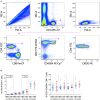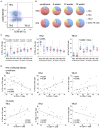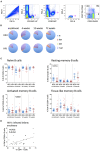Normalization of B Cell Subsets but Not T Follicular Helper Phenotypes in Infants With Very Early Antiretroviral Treatment
- PMID: 33996678
- PMCID: PMC8118125
- DOI: 10.3389/fped.2021.618191
Normalization of B Cell Subsets but Not T Follicular Helper Phenotypes in Infants With Very Early Antiretroviral Treatment
Abstract
Introduction: Infant HIV-1-infection is associated with high morbidity and mortality if antiretroviral treatment (ART) is not initiated promptly. We characterized development of circulating T follicular helper cells (cTfh) and their relationship to naïve/memory B cell subsets in a cohort of neonates initiating ART within the first week of life. Methods: Infants were diagnosed within 48 hours of birth and started ART as soon as possible. The frequency and phenotype of cTfh and B cells were analyzed at enrollment (birth -19 days) and at 4, 12, and 72 weeks of age in blood of 27 HIV-1-intrauterine-infected and 25 HIV-1 exposed uninfected (HEU) infants as part of a study in Johannesburg, South Africa. cTfh cells were divided into Tfh1, Tfh2, and Tfh17 subsets. B cell phenotypes were defined as naïve, resting memory, activated memory and tissue-like memory cells. Results: HIV-1-infected infants had higher frequencies of cTfh cells than HEU infants up to 12 weeks of age and these cTfh cells were polarized toward the Tfh1 subset. Higher frequencies of Tfh1 and lower frequencies of Tfh2 and Tfh17 correlated with lower CD4+ T cell percentages. Lower frequencies of resting memory, with corresponding higher frequencies of activated memory B cells, were observed with HIV-1 infection. Importantly, dysregulations in B cell, but not cTfh cell, subsets were normalized by 72 weeks. Conclusion: Very early ART initiation in HIV-1-infected infants normalizes B cell subsets but does not fully normalize perturbations in cTfh cell subsets which remain Tfh1 polarized at 72 weeks. It remains to be determined if very early ART improves vaccine antibody responses despite the cTfh and B cell perturbations observed over the time course of this study.
Keywords: B cells; HIV-1; cTfh; early antiretroviral therapy; infants.
Copyright © 2021 Shalekoff, Loubser, Dias, Strehlau, Shiau, Wang, He, Abrams, Kuhn and Tiemessen.
Conflict of interest statement
The authors declare that the research was conducted in the absence of any commercial or financial relationships that could be construed as a potential conflict of interest.
Figures





Similar articles
-
Frequencies of Circulating Th1-Biased T Follicular Helper Cells in Acute HIV-1 Infection Correlate with the Development of HIV-Specific Antibody Responses and Lower Set Point Viral Load.J Virol. 2018 Jul 17;92(15):e00659-18. doi: 10.1128/JVI.00659-18. Print 2018 Aug 1. J Virol. 2018. PMID: 29793949 Free PMC article.
-
Abnormal Shift in B Memory Cell Profile Is Associated With the Expansion of Circulating T Follicular Helper Cells via ICOS Signaling During Acute HIV-1 Infection.Front Immunol. 2022 Feb 10;13:837921. doi: 10.3389/fimmu.2022.837921. eCollection 2022. Front Immunol. 2022. PMID: 35222430 Free PMC article.
-
A pilot study on the characteristics of circulating T follicular helper cells in liver transplant recipients.Transpl Immunol. 2018 Apr;47:32-36. doi: 10.1016/j.trim.2018.01.003. Epub 2018 Feb 2. Transpl Immunol. 2018. PMID: 29360498
-
Activation of circulating TFH17 cells associated with activated naive and double negative 2 B cell expansion, and disease activity in systemic lupus erythematosus patients.Arthritis Res Ther. 2024 Sep 11;26(1):159. doi: 10.1186/s13075-024-03394-7. Arthritis Res Ther. 2024. PMID: 39261963 Free PMC article.
-
The Impact of HIV on B Cell Compartment and Its Implications for COVID-19 Vaccinations in People with HIV.Vaccines (Basel). 2024 Dec 5;12(12):1372. doi: 10.3390/vaccines12121372. Vaccines (Basel). 2024. PMID: 39772034 Free PMC article. Review.
Cited by
-
Immune Modulation of HIV-1 Reservoir Size in Early-Treated Neonates.J Infect Dis. 2023 Aug 11;228(3):281-286. doi: 10.1093/infdis/jiad173. J Infect Dis. 2023. PMID: 37201510 Free PMC article.
-
State-of-the-Science of human papillomavirus vaccination in women with human immunodeficiency Virus: Summary of a scientific workshop.Prev Med Rep. 2023 Jul 19;35:102331. doi: 10.1016/j.pmedr.2023.102331. eCollection 2023 Oct. Prev Med Rep. 2023. PMID: 37576844 Free PMC article. Review.
-
Accelerated CD8+ T cell maturation in infants with perinatal HIV infection.iScience. 2024 Apr 10;27(5):109720. doi: 10.1016/j.isci.2024.109720. eCollection 2024 May 17. iScience. 2024. PMID: 38706858 Free PMC article.
References
-
- Luzuriaga K, Tabak B, Garber M, Chen YH, Ziemniak C, McManus MM, et al. . HIV type 1 (HIV-1) proviral reservoirs decay continuously under sustained virologic control in HIV-1-infected children who received early treatment. J. Infect. Dis. (2014) 210:1529–38. 10.1093/infdis/jiu297 - DOI - PMC - PubMed
-
- Tagarro A, Chan M, Zangari P, Ferns B, Foster C, De Rossi A, et al. . Early and highly suppressive antiretroviral therapy are main factors associated with low viral reservoir in European perinatally HIV-infected children. J. Acquir. Immune Defic. Syndr. (2018) 79:269–76. 10.1097/QAI.0000000000001789 - DOI - PMC - PubMed
Grants and funding
LinkOut - more resources
Full Text Sources
Other Literature Sources
Research Materials

